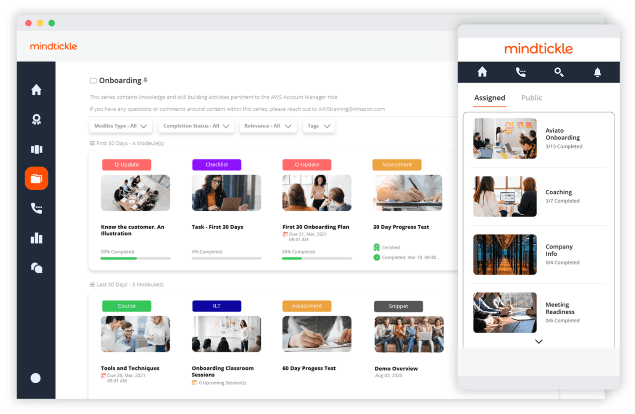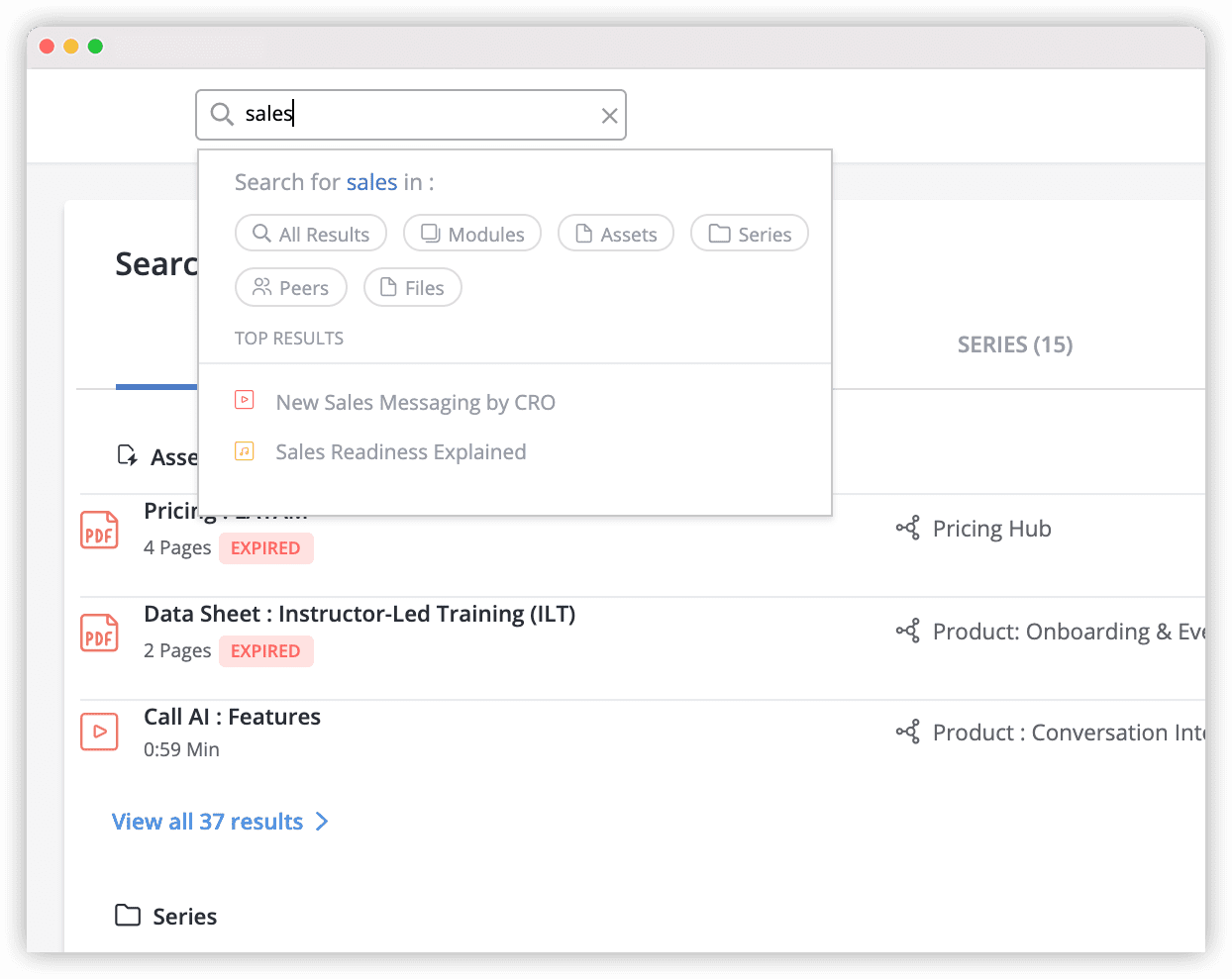In 1996, Bill Gates famously penned an article titled “Content is King.” Though the article is now a quarter of a century old, the sentiment has never been more true – especially for sales organizations.
There’s no doubt sales content is a key ingredient of sales readiness and selling success. And it comes in many forms. Internal content, such as product updates delivered via easy-to-consume microlearning, ensures sellers are always up-to-date, access and use accurate, consistent messaging, and are able to convey the value of their solution. On the other hand, the right marketing-approved assets enable sellers to deliver relevant content to customers throughout the selling cycle. This external content helps sellers increase engagement, set traps for the competition, and move deals through the funnel more quickly.
But getting the right content in sellers’ hands is rife with obstacles – for both sellers and administrators. If they’re going to arm salespeople with content that improves deal outcomes, organizations need to rethink what kind of content is shared, how it’s shared, and how it’s used.
It’s time for sales organizations to provide integrated sales content experiences for just-in-time learning and customer engagement.
At many organizations, content chaos is the norm
Virtually every sales enabler and marketer spends a lot of time creating content to support the sales team. Different content serves different roles – and it can take many different formats. For example, “internal use only” tools such as just-in-time training and recordings of top sellers in real-world interactions help reps prepare for upcoming meetings more effectively. And customer-facing assets such as pitch decks and sell sheets can help accelerate deals.
The right content can have a significant, positive impact on a rep’s ability to close more deals. But according to SiriusDecisions, up to 70% of B2B content goes unused. And one of the chief reasons is that sellers don’t know the content exists. Or, if they do, they don’t know how or where to find it.
Because multiple stakeholders create sales content, storing and managing content gets out of control – and quickly. Keeping content in Google Drive, Dropbox, or SharePoint may have sounded like a good idea at the time, but making sure the current messaging, positioning, or competitive talking points are being accessed becomes an impossible task when your content repository wasn’t built for the task.
Even worse, there’s no organization of content along business lines. If a rep wants to see an example of pitching against a competitor, watch an SME video about the competitor, and then share some marketing assets for the same purpose, will all of that information be in the same place? Will it be up-to-date? Will there only be one copy of all of it? If your organization is like most, the answers to these questions are no, no, and no.
It’s content chaos, and sellers don’t have what they need to succeed.
Modern sellers need integrated content experiences to succeed in the field
Today’s B2B sellers have high expectations. Sellers must walk into meetings ready to deliver value, and content is a big piece of the readiness puzzle. In fact, according to the CMO Council, 87% of B2B buyers indicate content has a major or moderate impact on their purchase decisions.
Organizations must make it a priority to provide integrated content experiences that empower reps to access, learn, and share the right content at the right time. Whether it’s an internal competitive update from a subject matter expert or a marketing-approved, customer-facing brochure, content should be housed in a single, easily searchable platform. The problem is that conversation intelligence data – which can provide those real-world conversation snippets reps find so valuable – is often housed in an entirely different location than just-in-time learning content and marketing assets, making a single platform more of a fantasy than reality.
Reps need content stored in intuitive hubs that match business workflows. The subject matter in hubs may be competitors, personas, industries, sales plays, etc. But it’s hard to create these hubs when data comes from multiple locations.

Instead, you need a centralized location like Mindtickle’s Asset Hub, that pulls data from other aspects of your sales stack – enablement, conversation intelligence, etc. – and delivers it in one integrated solution. Then your content becomes more valuable, it’s used more frequently and effectively, and your reps become more consistent and productive.
Reduces time wasted on searching for content
Research suggests that reps spend less than a third of their time on revenue-generating activities. The remainder of their time is spent on myriad other activities, including paperwork, training, and servicing customers. Of course, those are all important tasks. However, a good chunk of a reps’ time is also spent doing busy work – including hunting down the right content. And if they can’t find what they need, they may take matters into their own hands and sink even more time into developing their own content from scratch. And we’ve all seen how that ends.
An integrated content experience ensures reps can always find exactly what they’re looking for, quickly. That means they can spend less time hunting for content and guessing which will help improve sales outcomes – and more time doing what they do best: selling.


Ensures accurate, consistent messaging across the sales team
Let’s say the enablement team sends out a new sell sheet via email. But shortly after it’s been released, the content becomes outdated. Reps save the sheet and continue sharing it, even after it’s been updated, and propagate outdated information to their buyers. This scenario happens thousands of times per day, and enablement teams often feel powerless to do anything about it.
Providing reps with one-stop content access for all of their training and sharing needs ensures they have a single source of truth when it comes to content. They know they can easily find the approved version of what they need and deliver accurate, consistent messaging during sales interactions.
Better win rates
If a seller can’t find a piece of content to address a customer’s needs and objections at a specific stage of the sales cycle, it can slow down a deal.
With integrated content experiences – where content is both arranged in business-focused hubs and easily searchable – reps have access to all of the content they need in a single location. And when admin teams can easily manage content and correlate both training and marketing content to business outcomes, reps also know the content they use has been successful with top reps.
With the right content and insights into content effectiveness, reps can more effectively communicate with prospects, overcome objections, and build a strong case for their solution. They’re better equipped to close more business – faster.
End the content chaos
Sales reps need access to the right content at the right moment to move more deals forward. But a disjointed approach to content management doesn’t cut it. To turn chaos into structure, organizations need an integrated platform with three key attributes:
- Integrated enablement, conversation intelligence, and just-in-time content to create a tight bond between training and selling
- Centralized administration to ensure the right content is always available – and the wrong content isn’t
- And insights into content effectiveness, helping stakeholders across the organization understand the impact of content for both training and selling







